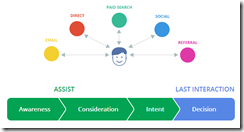Have you noticed recently that your web browsing experience is becoming narrower, more confined and focused? What about those pesky ads that follow you from one website to another? Do they annoy or help you? It seems that all it takes is one visit to a retail website, and next thing you know, that retailer’s ads are stuck to your computer screen, appearing in every available ad spot across the web.
If this sounds like you – then you’re not alone. You’re actually part of the newly emerging real time web that combines big data and analytics to track and target you in search of that all-consuming sales conversion.
Businesses are putting their data to work
There has been significant progress in the world of analytics in recent times. The masses of data that has been collected for decades is now, thanks to the meshing of powerful, purpose built hardware and software, available to business decision makers at the touch of a screen or click of a mouse. This on-premise information is a rich source of vitality data that – with the appropriate mapping and analysis, can reveal hidden truths about our customers, their lives, lifestyles and even their futures.
Meanwhile, customers are themselves, increasingly self-tagging, self-identifying and self-analyzing their daily activities, weekly routines and personal aspirations. This information, in turn, is floating around the web, being stored, collated and cross-referenced to improve the effectiveness of our communal and personal web experiences. From the captcha codes that Google uses to improve its OCR book scanning to the social media check-ins that Facebook and ad networks use to micro-target and re-target advertising, the potential for augmenting a business’ on-premise data with publicly available “big data” is revolutionary.
The emergence of synthalitics will change marketing
“Synthalitics” is the combining of public data with business data, cross-pollinated with customer’s business and credit history, matched with their real time social and location-based information – and made available for a business rules engine at point of interaction. It may sound far-fetched, but it already available in a crude form that will improve as software and hardware improve. Just look to real time bidding advertising networks and ad re-targeting.
These are the pesky ads that follow you from one website to another. The technology clearly works, but advertisers have yet to apply creativity and insight to the re-targeting process. Rather than playing the same ad over and over, ad networks and advertisers will need to become more nuanced in their efforts and connected in their digital storytelling before these feel anything other than intrusive. But this will happen. And what currently appears clunky will, in very short order, become common place – and if we (as consumers) are lucky, it may even become useful.
The growth in real time bidding (RTB) display advertising indicates that businesses are rapidly acclimatizing to this digital world. In the US, RTB spending was expected to hit $3.34 billion in 2013 representing a massive 73.9% growth over the previous year. By 2017, eMarketer suggests this figure will hit $8.69 billion. The automation of digital display will create a gulf between those brands that understand and can integrate digital formats into their strategy and those that can’t – and clearly, this will accelerate through 2017.
Synthalitics deliver one-to-one engagement at scale
However, RTB is just one part of the digital story. Marketers need tools that can absorb the vitality data, augment it with big data-like, location based, self reported data (available through smartphones and social check-ins) and corporate CRM data and synthesize it in such a way that it reveals new and potentially predictive patterns (see diagram below). This is about knowing who your buyers trust.
 Increasingly, sales and marketing teams will need to work through a central platform to be able to contextualize business critical information about a prospect’s digital behaviour, needs and expectations. Or if no central platform or suite of tools are available, the need for frictionless data and aggregation points will become vital. The gulf between digitally-enabled and analogue businesses will grow, with the former over-running and out-innovating the latter.
Increasingly, sales and marketing teams will need to work through a central platform to be able to contextualize business critical information about a prospect’s digital behaviour, needs and expectations. Or if no central platform or suite of tools are available, the need for frictionless data and aggregation points will become vital. The gulf between digitally-enabled and analogue businesses will grow, with the former over-running and out-innovating the latter.
Businesses without a digital transformation agenda need to rapidly reassess their strategy and go to market models. In short order – synthalitics will transform marketing and sales as we know it. And it is synthalitics that will deliver on the promise of one-to-one engagement at scale.
The question for you and your brand is not whether you are READY, but whether you have even STARTED.













